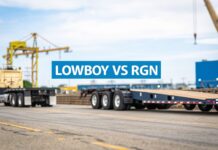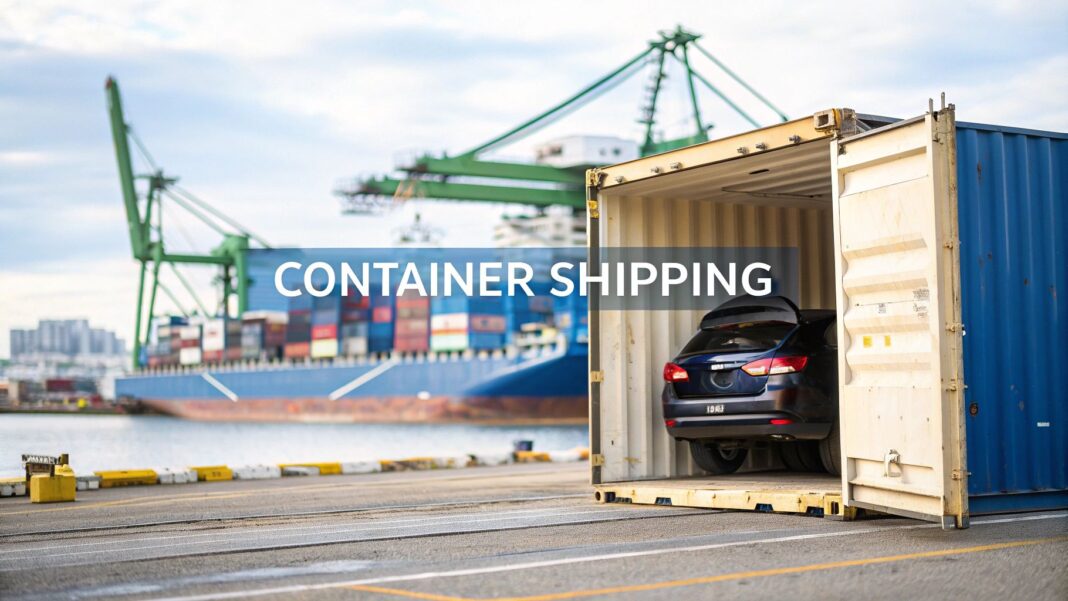
Shipping a car in a container means your vehicle is professionally loaded and secured inside a sealed, weatherproof steel container for transport. This method provides a private, armored enclosure for your vehicle's journey, whether it's crossing an ocean, traveling by rail, or moving by truck.
This approach offers the highest level of protection available. It shields your car from weather, road debris, and potential transit damage, making it the preferred choice for international shipments, classic cars, and high-value vehicles.
Your Guide To Shipping A Car In A Container
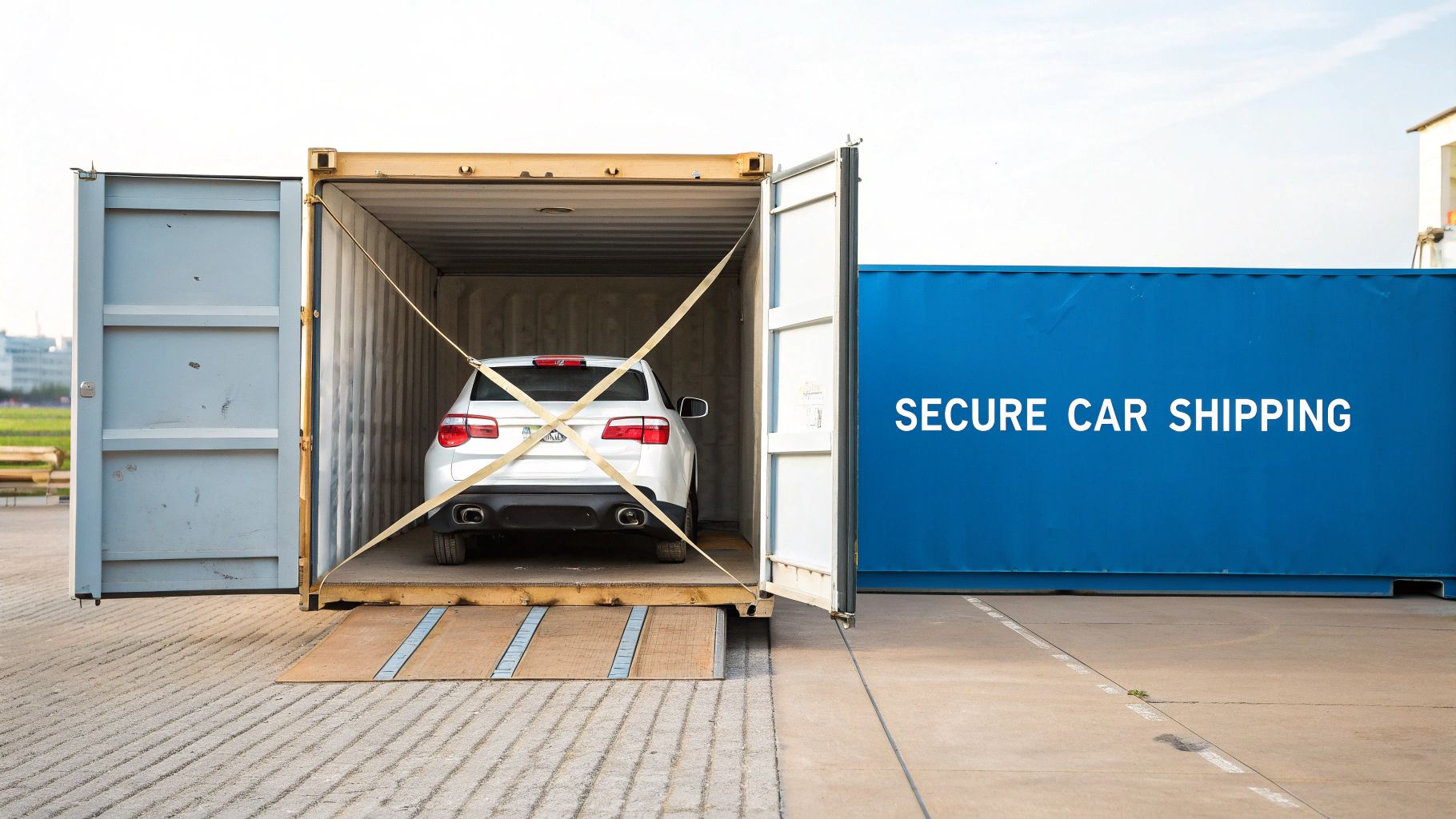
When moving a vehicle, particularly over long distances or internationally, ensuring its safety is paramount. While several transport methods exist, shipping a car in a container provides a level of security that other options cannot match. From loading to arrival, your car remains protected within its own steel shell.
This guide provides actionable information on your options, cost factors, and the step-by-step process to ensure your vehicle reaches its destination securely and efficiently.
Container shipping is the optimal solution for:
- High-Value Vehicles: Protect classic, luxury, or exotic cars from road grime, weather, and potential theft.
- International Moves: A container simplifies complex overseas logistics and helps streamline customs clearance.
- Non-Running Vehicles: Project cars or inoperable vehicles can be professionally winched and secured for safe transport.
- Enhanced Security: A locked, sealed steel container is a powerful deterrent against theft and vandalism, offering maximum peace of mind.
Why Container Shipping Is A Reliable Choice
The container shipping industry operates on a massive, highly organized global network, ensuring frequent and dependable sailing schedules. This system is trusted to move billions of dollars in valuable cargo, and vehicles are handled with the same professional care.
To illustrate the scale, global container volume in the first half of 2025 grew by 4.5% to 93.5 million TEUs (twenty-foot equivalent units), with intercontinental shipments increasing by 4.7%. This volume demonstrates a system built for efficiency and security.
By choosing container shipping, you are utilizing a global logistics framework engineered for safety. Your vehicle is treated as a valuable asset, secured within its own dedicated steel vault for the entire journey.
A critical first step is to check the standard dimensions of a 20 ft container. This will help you confirm if your vehicle—and any personal items you may ship in a dedicated container—will fit properly.
Understanding these details is fundamental to a smooth shipping process. If you're exploring all transport avenues, our professional car transport services can provide a comprehensive look at every available method.
Choosing Your Container Shipping Option
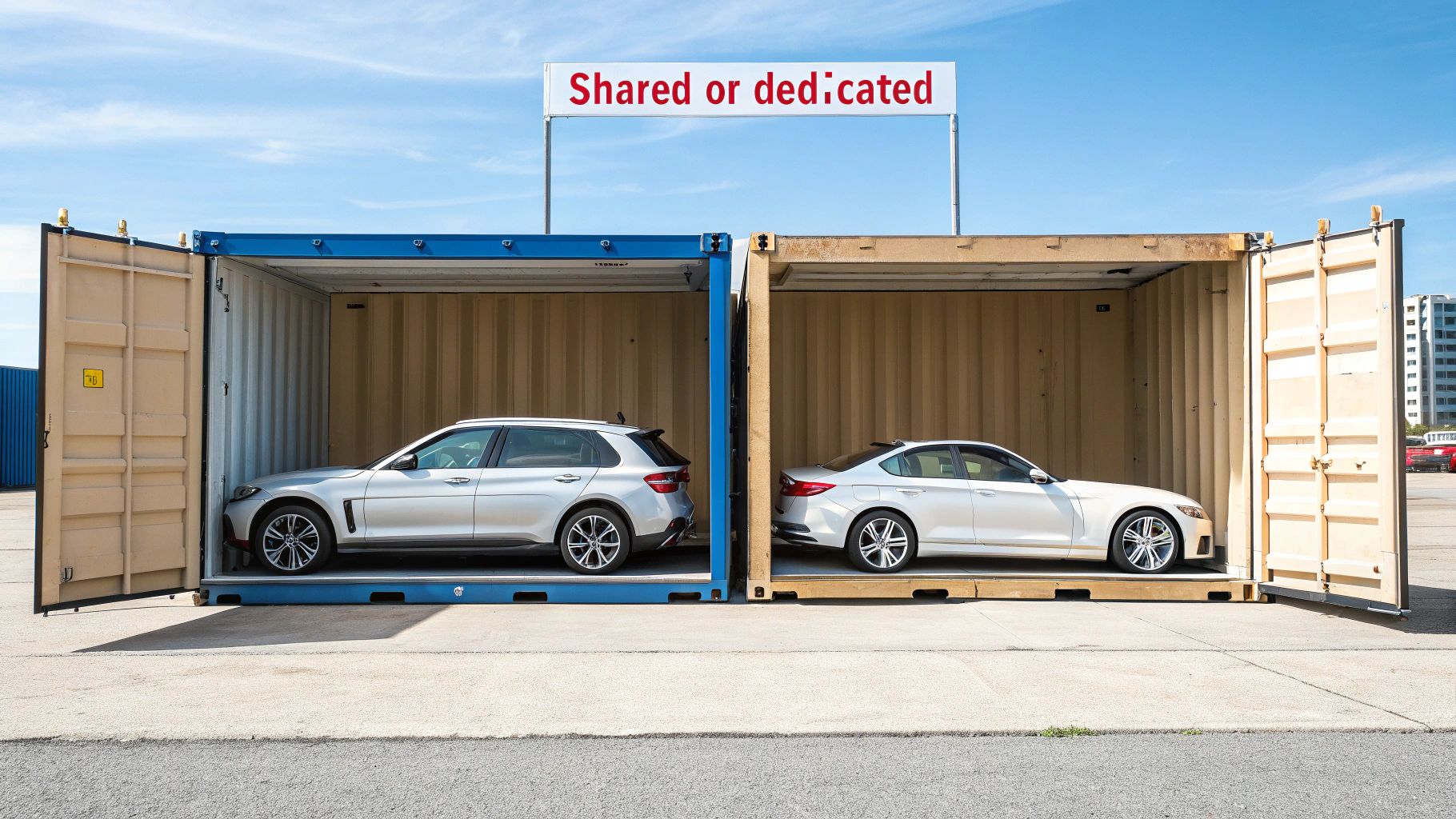
When shipping your car in a container, you have two primary options: sharing container space to reduce costs or reserving a private container for your exclusive use. Your choice directly impacts the cost, transit time, and overall logistics of your shipment.
The first option is a shared container, where your car is loaded into a large, typically 40-foot container with other vehicles bound for the same destination. The second is a dedicated container, which provides an exclusive space for your vehicle. Each has distinct advantages, and the best choice depends on your priorities.
The Carpool Approach: Shared Container Shipping
Shared container shipping, also known as consolidated shipping, is the most common choice as it balances cost-effectiveness with high security. In this method, a logistics team professionally loads and secures multiple vehicles into a single container. The total cost of shipping is then divided among all the vehicle owners.
This is a financially practical choice for standard vehicles. The primary trade-off is time; the container cannot be shipped until it is fully loaded with all assigned vehicles, which may introduce a waiting period before departure.
If you have a flexible timeline and your priority is leveraging the security of a container at a lower price point, shared shipping is an excellent and practical option.
The Private Chauffeur: Dedicated Container Shipping
A dedicated container, or Full Container Load (FCL), provides an entire 20-foot or 40-foot container for your exclusive use. This is the premium service for shipping car container transport, offering maximum speed, security, and flexibility.
Since you are not waiting for other vehicles, your container is scheduled for shipment as soon as your car is loaded. This significantly reduces transit time, making it the ideal choice for high-value classic cars, luxury vehicles, or time-sensitive moves.
A key advantage is the ability to ship personal belongings along with your vehicle, which is typically prohibited in a shared container. This is highly beneficial for international relocations, allowing you to consolidate your car and household goods. While the cost is higher, the convenience and control are significant benefits.
Opting for a dedicated container provides complete control over your shipment. You determine the schedule and have exclusive use of the space, ensuring your vehicle receives singular attention from loading to unloading.
Your specific needs will determine the best choice. If neither of these options aligns with your budget, other methods are available. For instance, open transport car shipping is generally the most economical way to move a vehicle domestically.
To clarify your decision, the table below outlines the key differences.
Shared Container vs Dedicated Container Shipping
This table provides a direct comparison to help you select the optimal service for your vehicle and shipping requirements.
| Feature | Shared Container (Consolidated) | Dedicated Container (Sole Use) |
|---|---|---|
| Cost | Lower, as costs are split among multiple customers. | Higher, as you pay for the entire container space. |
| Speed | Slower, as the container must be full before shipping. | Faster, with immediate shipping once your car is loaded. |
| Security | High level of protection inside a sealed container. | Highest level of protection and exclusive access. |
| Flexibility | Less flexible; no personal items allowed. | Highly flexible; personal belongings can be shipped. |
| Best For | Budget-conscious shippers with flexible timelines. | High-value vehicles, urgent shipments, and relocations. |
Ultimately, the right choice aligns with your budget, timeline, and the specific needs of your vehicle. Carefully consider these factors before making your final booking.
Breaking Down the Cost of Container Shipping
Calculating the cost to ship a car in a container involves several key factors. The final quote is not an arbitrary number but a precise calculation based on your chosen service, the transport distance, and your vehicle's specifications.
Understanding these components will allow you to budget effectively and avoid unexpected charges. The core principles are similar to booking freight: distance, space, and handling requirements determine the final price.
Core Cost Factors You Control
Your initial decisions have the greatest impact on the total cost. The primary factor is distance. Shipping a car from New York to London will naturally cost more than a shorter domestic route due to higher fuel consumption, longer transit times, and increased labor.
Next, the size and weight of your vehicle are critical. A standard sedan requires less space and simpler handling than a large SUV or a heavy-duty truck like an F-250. Larger, heavier vehicles occupy more container space and may require specialized equipment for loading, which is reflected in the price.
Finally, your choice between a shared or dedicated container significantly influences your budget.
- Shared Container: This is the most cost-effective option. You share the space—and the cost—of a 40-foot container with other vehicle owners, reducing your individual expense.
- Dedicated Container: This is the premium choice. You secure an exclusive 20-foot or 40-foot container. It costs more but provides a faster, more flexible shipping schedule and the ability to include personal items.
Understanding Additional Fees and Charges
Beyond the base freight rate, your invoice will include several standard industry charges. These are not hidden fees but necessary costs associated with port operations and international regulations.
You will encounter port fees, or terminal handling charges, which cover the labor and equipment required to load and unload your container at the ports of origin and destination. These are a standard, unavoidable component of all container shipments.
For international transport, customs duties and taxes are a significant consideration. These government-levied fees vary by country and are typically calculated based on the vehicle's declared value. An experienced shipper is invaluable here, as they can help you navigate the required documentation to ensure compliance.
It is also vital to recognize that the global shipping market is dynamic. Freight rates fluctuate based on supply, demand, fuel costs, and geopolitical events, which can directly affect your container's base cost.
This market volatility is an important factor. For example, the cost to book a container can shift monthly due to global trade volumes. Major freight indexes track these changes. The Drewry World Container Index, for example, saw a 3% increase to $1,746 per 40ft container in October 2025, illustrating these market adjustments.
The Role of Insurance Coverage
While professional shipping companies exercise extreme care, insurance provides essential financial protection. Basic liability coverage is typically included but often has limits that may not cover your vehicle's full value. For this reason, supplemental insurance is highly recommended, especially for high-value, classic, or sentimental vehicles.
The cost of additional coverage is usually a small percentage of the vehicle's insured value. It protects your investment against unforeseen events, such as damage from turbulent seas or other transit-related incidents.
When requesting a quote, always clarify the included insurance level and inquire about options for comprehensive coverage. To understand how these factors apply to your specific needs, get a free shipping quote for a complete, transparent cost breakdown.
Navigating The Container Shipping Process Step by Step
Shipping a car in a container is a structured process with clear stages. By understanding the workflow, from obtaining a quote to receiving your vehicle, the entire operation becomes manageable and predictable.
You are responsible for vehicle preparation and documentation, while your shipping partner handles the complex logistics. This clear division of responsibilities ensures a smooth and efficient transport experience.
Stage 1: The Quote and Booking Phase
The process begins when you request a quote. You will need to provide basic information: your vehicle's make and model, its pickup location, and the final destination. With these details, we can provide an itemized estimate outlining all costs associated with your shipping car container service.
Once you approve the quote and are ready to proceed, you will complete the booking. This involves signing a shipping agreement, providing a deposit, and confirming all logistical details. This step secures your booking and initiates the transport planning.
Stage 2: Vehicle Preparation and Pickup
Next, you must prepare your vehicle and its documentation for transport. This stage is critical for an efficient handover. You will need to gather essential paperwork—such as the vehicle title and a copy of your photo ID—and prepare the car by cleaning it and ensuring the fuel tank is at approximately 1/4 full.
Once your car and documents are ready, we will schedule the pickup. A professional carrier will collect your vehicle and transport it to the designated port or loading warehouse. At this point, your shipping partner assumes responsibility for the vehicle's transit.
Stage 3: Loading and Ocean Transit
At the port or warehouse, your vehicle is professionally loaded into its designated container. This process uses specialized equipment to ensure it is completely secure. Technicians use industrial-grade wheel chocks and high-tension straps to immobilize the vehicle, preventing any movement during its journey.
After the container is loaded and sealed, it is transferred onto the vessel. The ocean transit is typically the longest part of the process, lasting from several weeks to over a month depending on the shipping lane.
The infographic below highlights the key variables that influence your shipping plan, from vehicle size to transport distance.
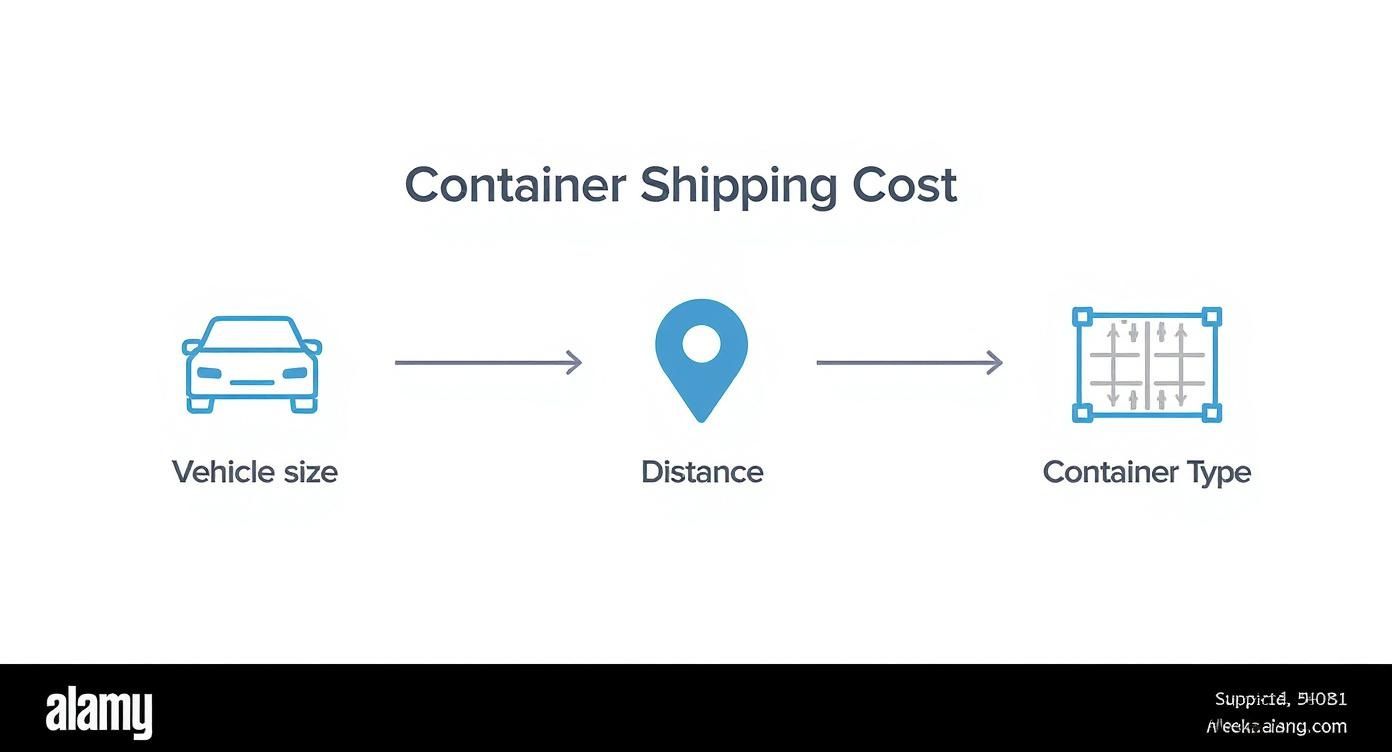
As shown, these factors are the core components that determine both your final cost and the overall transit timeline.
You will be provided with a container tracking number, allowing you to monitor its progress online as it travels across the ocean.
For enhanced tracking, you can explore independent monitoring solutions. This vehicle GPS tracker guide offers valuable information on how to monitor your car's location in real-time.
Stage 4: Customs Clearance and Final Delivery
Upon arrival at the destination port, the container must undergo customs clearance. Our team or a designated local agent will manage and submit all required documentation to the relevant authorities on your behalf. With proper documentation, this is a straightforward administrative procedure.
Once cleared, the container is moved to a secure facility for unloading. You will be notified as soon as your vehicle is ready for collection. Depending on your service agreement, you can either pick it up from the port facility or have it delivered directly to your specified address.
Getting Your Car and Paperwork Ready for Shipment
A successful shipping car container transport begins with proper preparation. Organizing your vehicle and documents in advance is the most effective way to prevent delays, avoid unexpected fees, and ensure a seamless handover to the transport company.
The preparation process is divided into two main categories: assembling the required documentation and physically preparing your vehicle for transit. Completing these steps correctly sets the stage for a successful shipment.
Your Essential Documentation Checklist
Before a vehicle can be shipped, we must verify your identity and proof of ownership. This is a standard industry requirement mandated by transport regulations to prevent fraud and theft. Incomplete or incorrect paperwork is the most common cause of shipping delays.
Gathering these documents early ensures the pickup process is efficient and hassle-free. You will need:
- Original Vehicle Title: This is non-negotiable proof of ownership. The name on the title must match your identification. If there is a lien on the vehicle, a notarized letter from the lienholder (your bank) authorizing the shipment is required.
- Copy of Registration: A current vehicle registration is necessary to prove the vehicle is legally documented.
- Photo Identification: A clear copy of your driver's license or passport is required for identity verification.
- Bill of Lading: This is the official contract between you and the transport company. This document will be provided at the time of pickup for your signature.
For international shipments, additional documentation will be required, such as an export power of attorney form or country-specific import documents. Our logistics specialists will provide a clear list of all necessary paperwork for your specific route.
The global shipping industry relies on standardized, accurate documentation to manage the millions of containers in transit. Major carriers move vast fleets across the globe, and precise paperwork is essential to this complex logistical network.
This logistics network is operated by massive carriers. For example, a leading carrier like MSC operates a fleet of over 930 vessels with a total capacity of 6.76 million TEUs as of mid-August 2025. These figures underscore why accurate documentation is critical for the system to function. You can explore more global shipping data and trends at AXSMarine.
The Vehicle Preparation Checklist
With your documents in order, the next step is to prepare your vehicle for its journey. Following this checklist protects your car and ensures compliance with safety regulations for container transport.
- Clean Your Vehicle Thoroughly: Wash the exterior and clean the interior. A clean vehicle allows for an accurate vehicle condition report at pickup, where any existing scratches or dings can be properly documented.
- Fuel Tank at 1/4 Full: For safety, the fuel tank must not be more than one-quarter full. This provides enough fuel for loading and unloading maneuvers while minimizing the risk associated with transporting flammable materials.
- Remove All Personal Belongings: This is a critical step. Unless you have booked a dedicated container and received written confirmation that personal items are permitted, the vehicle must be completely empty. This includes all personal effects, as shipping companies are not liable for items left inside.
- Document the Vehicle's Condition: Use your smartphone to take detailed photos and videos of your car from all angles, both inside and out. Capture close-ups of any pre-existing damage. This documentation serves as your personal record in the unlikely event of a damage claim.
- Secure Loose Parts and Alarms: Retract or remove antennas, fold in side mirrors, and disable any aftermarket alarm systems. If you have a convertible, ensure the top is securely latched to prevent damage during transit.
Completing these steps helps ensure your vehicle is transported safely and efficiently, contributing to a smooth and successful delivery.
Getting to Grips with International Customs and Regulations
Shipping a car internationally involves navigating a complex web of customs regulations. Each country has its own set of rules, and a minor error in documentation can result in your vehicle being detained at the port, leading to significant delays and storage fees.
Customs brokers and freight forwarders are essential experts in this domain. These licensed professionals are specialists in international trade law and logistics. Their role is to ensure that your shipping car container complies with all regulations, facilitating a smooth passage through customs.
The Key Players on Your Shipping Team
Transporting a vehicle between countries requires a coordinated effort. The customs broker and freight forwarder are two of the most critical members of this team, managing different but equally vital aspects of the process.
- Customs Broker: A licensed professional who acts as your legal representative at the border. They ensure your shipment complies with all import laws of the destination country and handle communication with customs officials.
- Freight Forwarder: The logistics coordinator for your shipment. They book the container space on the vessel, arrange inland transport, and manage the physical movement of your vehicle from origin to destination.
When you partner with an experienced full-service company like We Will Transport It, these services are typically integrated. This provides you with a single point of contact responsible for overseeing the entire process, greatly simplifying the experience.
What About Duties, Taxes, and Exemptions?
A common question is about the cost of import taxes. These duties and taxes are determined by the destination country's government and are usually calculated as a percentage of the vehicle's value. The rates can vary significantly between countries.
However, various exemptions may apply, potentially reducing your tax liability. For example:
- Returning Residents: Citizens moving back to their home country after residing abroad can often import their personal vehicle duty-free.
- Temporary Imports: If you are shipping a vehicle for a specific purpose, such as a race or tour, you can often secure a temporary import bond. This allows the vehicle to enter the country without paying full import duties, provided it is exported within a specified timeframe.
Navigating customs is more than just filing paperwork; it's about understanding the legal and financial regulations of your destination. A knowledgeable partner can identify applicable exemptions you might overlook, potentially saving you thousands of dollars.
Making Sure Your Car Meets Local Standards
In addition to taxes, your vehicle must meet the destination country's road safety and emissions standards. In the United States, for example, the Environmental Protection Agency (EPA) and Department of Transportation (DOT) enforce strict regulations.
A vehicle not originally manufactured for the U.S. market may require costly modifications to become compliant. The same applies to other countries with unique vehicle standards. An expert transport partner is crucial here. They will help you verify compliance before you ship, preventing a scenario where your vehicle is denied entry at the destination port.
Got Questions About Shipping a Car in a Container? We've Got Answers.
Even after reviewing the process, you likely have specific questions. This is perfectly normal. Here, we address some of the most frequently asked questions about shipping a car in a container to provide you with clear, actionable answers.
What Is the Safest Way to Ship a Car?
Container shipping is unequivocally the safest method for transporting a vehicle, particularly for long-distance or overseas journeys. Your car is secured inside a sealed steel container, which acts as a private vault, protecting it from weather, road hazards, and potential theft. This complete enclosure minimizes handling and eliminates exposure to the elements, making it the preferred choice for classic, exotic, or high-value vehicles.
In contrast, methods like RoRo (Roll-on/Roll-off) involve parking vehicles on a ship's deck, where they are exposed to sea air and the elements. For maximum protection and peace of mind, a sealed container is unmatched.
Can I Pack Personal Belongings in the Container with My Car?
The ability to include personal items depends entirely on the type of container service you select.
- Shared Container: In almost all cases, no. To streamline customs clearance and ensure the safety of all vehicles in the container, shipping personal items is prohibited.
- Dedicated Container: Yes. This is a primary benefit of booking an exclusive container. You can load personal effects and household goods alongside your vehicle, making it a highly practical solution for international relocations.
Always confirm the specific regulations with your shipping advisor before packing any additional items.
How Long Does Container Shipping Take?
Transit times vary based on the shipping route, destination, and the service option you choose. A domestic container move might take one to two weeks, while an international shipment typically takes four to eight weeks or more.
A dedicated container generally has a shorter overall transit time because it can be shipped as soon as your vehicle is loaded. A shared container requires a consolidation period while waiting for the container to be filled, which can add time at the origin port.
The total timeline includes more than just the time at sea. You must also account for ground transport to and from the ports, as well as the customs clearance process at the destination. A reliable shipping partner will provide a realistic, all-inclusive delivery window.
What’s the Difference Between Container and RoRo Shipping?
The fundamental difference lies in how the vehicle is transported. With container shipping, your car is professionally loaded, braced, and secured within a sealed container. With RoRo (Roll-on/Roll-off) shipping, the vehicle is driven directly onto a large vessel, similar to a multi-story parking garage, and parked for the journey.
RoRo is often more cost-effective and can be faster for standard, running vehicles. However, shipping a car in a container provides superior security. It is also the only viable sea freight option for non-running vehicles or if you intend to ship personal belongings with your car.
Ready to ship your vehicle with the security and confidence it deserves? The logistics pros at We Will Transport It are here to handle every last detail, ensuring your car arrives safe, sound, and on time. Get your free, no-obligation quote today!




